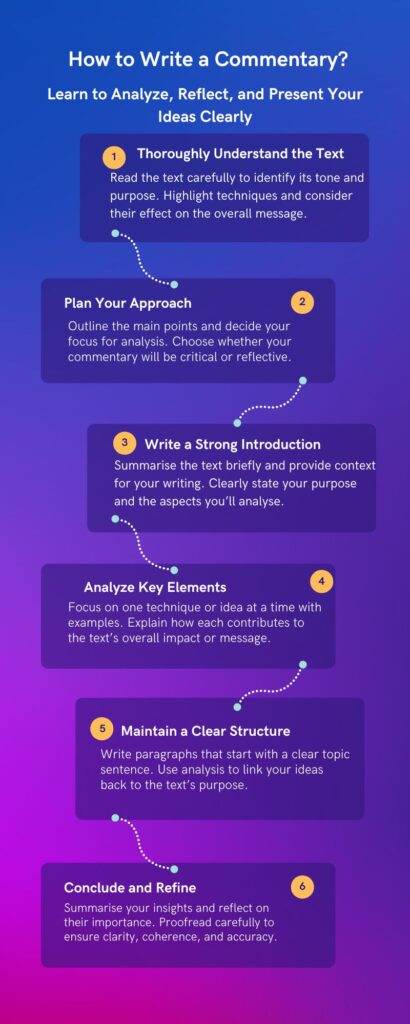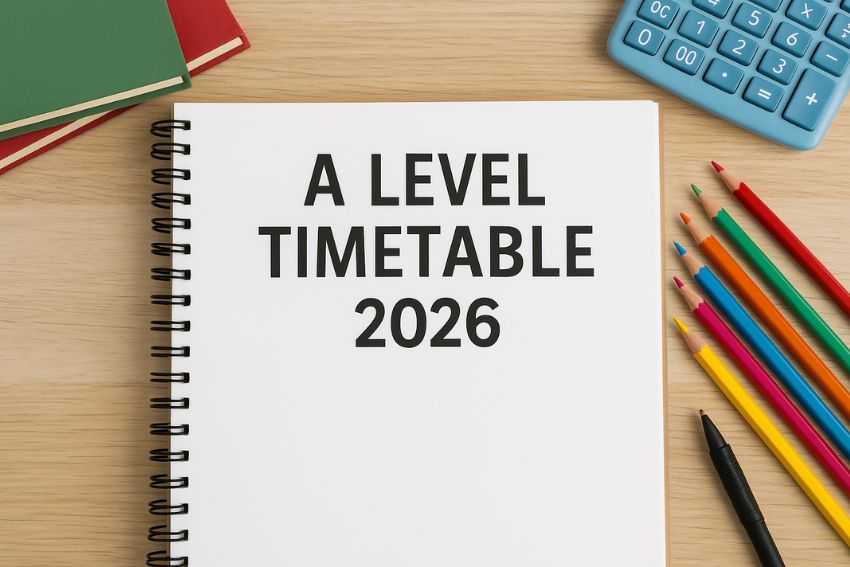How to Write a Commentary for A-Level English Language: A Complete Guide
How to write a commentary? To start with the definition- A commentary is a detailed analysis of a text that explores its techniques, themes, and meanings. It’s an essential skill in A-Level English Language, helping students demonstrate their understanding of how writers use language to achieve their goals.
In A-Level English, writing a commentary involves more than just summarising a text. It’s about identifying key elements, such as tone, structure, and literary techniques, and explaining their impact. This skill is particularly important for exams, where reflective and critical commentaries showcase a student’s ability to think deeply and communicate effectively.
In this guide, you’ll learn the steps to write a compelling commentary, see practical examples, and gain tips for crafting both reflective writing and critical analyses. Whether you’re preparing for an exam or improving your writing skills, this guide will make the process clear and approachable.

What Is a Commentary?
A commentary is a structured analysis and interpretation of a text or source. It goes beyond summarising to examine how the writer uses language, techniques, and structure to achieve their purpose. In A-Level English Language, writing a commentary allows students to showcase their understanding of a text while developing critical and reflective thinking skills.
There are two main types of commentaries: critical commentary and reflective commentary.
| Type of Commentary | Description |
| Critical Commentary | Analyzes and evaluates the writer’s choices in a text. It examines how tone, structure, and techniques contribute to the overall impact. |
| Reflective Commentary | Explores the writer’s thought process behind their own work. It discusses the choices made and their contribution to the theme or message. |
Learning how to write a commentary is a valuable skill for A-Level English Language, as it helps students think critically and communicate their insights clearly. In the next sections, we’ll break down the steps and tips for writing both critical and reflective commentaries effectively.
Why Is Commentary Important in A-Level English Language?
Writing a commentary is a crucial skill in A-Level English Language because it helps students understand texts on a deeper level. By analyzing and interpreting a writer’s choices, you can uncover the techniques they use to convey their ideas. This process sharpens your analytical skills and improves your ability to evaluate language critically.
In exams, commentaries are used to assess your ability to think deeply and write clearly. Whether it’s a critical commentary analyzing a text or reflective writing about your own work, this skill shows how well you can articulate your thoughts. Knowing how to write a commentary for A-Level English Language gives you the confidence to approach texts with clarity and purpose.
By mastering commentary writing, you not only enhance your exam performance but also develop skills that are valuable beyond the classroom, such as critical thinking and effective communication. Let’s now explore the steps to create a well-structured commentary.
How to Write a Well-Structured Commentary
Writing a commentary may seem daunting at first, but breaking it down into clear steps can make the process more manageable. A well-structured commentary not only demonstrates your understanding of the text but also showcases your ability to organise and present your thoughts effectively. Here’s a step-by-step guide to help you craft a compelling commentary:
How to Write a Commentary: Understand the Text Thoroughly
Before you learn how to write a commentary, which is well structured, take time to reread the text carefully. Pay close attention to its tone, purpose, and audience. Highlight key phrases, literary devices, or structural choices that stand out, and consider their significance. Ask yourself: What is the writer trying to achieve? How do their choices contribute to the overall message?
How to Write a Commentary: Plan Your Commentary
Planning is crucial to ensure your commentary is coherent and focused. Begin by outlining the key points you want to address. For a critical commentary, you might structure your analysis by techniques (e.g., tone, structure, imagery) or themes. For a reflective commentary, organise your discussion around the creative decisions you made in your own writing.
How to Write a Commentary: Start with an Engaging Introduction
Your introduction should briefly summarise the text or provide context for your writing (if it’s reflective). Clearly state the purpose of your commentary and the main aspects you’ll analyze. For example, you could mention the techniques you’ll explore or the overall effect you’ll evaluate.
How to Write a Commentary: Analyze in Detail
The body of your commentary is where you dive into the specifics. Focus on one key element at a time, such as tone, structure, or literary techniques, and explain how it contributes to the text’s overall impact. Use evidence from the text to support your points, such as quotations or examples, and always explain their relevance.
For Critical Commentaries: Discuss the writer’s choices and their effect on the reader. For example, how does the use of alliteration create emphasis? How does the structure build tension?
For Reflective Commentaries: Reflect on your own choices. Why did you use a specific metaphor? How does your structure mirror the theme of your writing?
How to Write a Commentary: Maintain a Clear Structure
Ensure each paragraph focuses on a single idea or technique. Begin with a topic sentence that introduces the point, follow with your analysis, and conclude by linking it back to the overall purpose of the text.
How to Write a Commentary: Conclude with Insight
Your conclusion should summarise your analysis and highlight its significance. For a critical commentary, this might involve discussing how the writer’s techniques contribute to the text’s success. For a reflective commentary, reflect on what you learned from the writing process and how your techniques conveyed your intended message.
How to Write a Commentary: Proofread and Edit
Before submitting your commentary, check for clarity, coherence, and technical accuracy. Ensure your analysis is well-supported and your ideas flow logically. Pay attention to grammar, punctuation, and spelling, as these can affect the quality of your writing.

What NOT to Do When Writing a Commentary
When learning how to write a commentary, it’s important to know what mistakes to avoid. Many students struggle with reflective writing because they focus too much on describing their work instead of analyzing it. Reflective writing isn’t about summarising, it’s about explaining why you made certain decisions and how they contribute to your message.
Another common mistake is ignoring the writer’s techniques or purpose. In reflective writing, always highlight the techniques you used and explain how they helped you achieve your goal. For example, if you used imagery to create a specific mood, explain why that mood was important for your theme.
Finally, don’t forget to support your points with evidence. Whether it’s a direct quote or a specific example from your work, evidence helps make your reflections clearer and more convincing. Without it, your commentary can feel vague or incomplete.
By avoiding these mistakes, you’ll be able to write thoughtful and effective commentaries that showcase your skills as both a writer and a critical thinker.
Conclusion
Mastering how to write a commentary is a crucial skill for A-Level English Language. It allows you to analyze texts deeply and communicate your ideas clearly. Both reflective writing and critical commentary play important roles in showcasing your ability to think critically and express yourself effectively.
Reflective writing, in particular, helps you understand your creative choices and grow as a writer. By practicing regularly, you’ll develop the confidence to evaluate your own work and explain the why behind your decisions. This skill not only improves your writing but also strengthens your self-awareness and critical thinking.
If you’re struggling or want to improve faster, consider seeking extra help from online A-Level English tutors. They can guide you through reflective writing and help you understand how to write a commentary for A-Level English Language. Tutors often provide personalised feedback, which can make a big difference in how you approach your writing.
Remember, the more you practice commentary writing, the easier it will become. Whether you’re analyzing a writer’s techniques or reflecting on your own, focus on staying thoughtful and specific. With consistent effort and the right support you’ll be well-prepared to excel in A-Level English Language and beyond. Keep writing, stay curious, and don’t hesitate to ask for help when you need it!
FAQs:
How to Write a Reflective Essay?
To write a reflective essay, introduce the experience and its importance. Describe what happened, share your thoughts, and reflect on what you learned. Connect it to your personal growth and conclude by summarising insights and how it shaped your future actions or perspective.
How to Write a Reflective Commentary?
Begin a commentary essay with a brief summary of the text or topic, introducing its purpose and key context. In the main body, analyze techniques such as tone, structure, and themes, explaining their impact on the audience. Support your analysis with specific evidence like quotes or examples. End with a conclusion that highlights the overall significance of the text and evaluates its effectiveness.
How to Write a Source Commentary?
When writing a source commentary, start by introducing the source, including its origin, purpose, and historical context. Then analyze its content, tone, and perspective, focusing on key points the source makes. Explain the social or historical background and how the source reflects its time. Finally, evaluate its reliability, bias, and usefulness, considering its strengths and limitations.
How to Write a Critical Commentary?
To write a reflective commentary, explain your piece’s purpose and goals. Reflect on creative choices like tone or imagery and why you made them. Discuss challenges, how you overcame them, and highlight your growth. Use examples from your work to support your points, and conclude by summarising what you’ve learned from the process.
How to Write a Commentary?
A commentary starts with an introduction that sets context and outlines your focus. In the body, analyze key elements like tone, structure, or techniques, explaining their purpose and impact. Use evidence, such as quotes or examples, to support your points. Conclude by summarising your analysis and emphasising the text’s overall significance.








